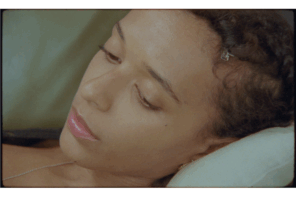A year after losing your apartment to a developer’s wrecking ball, after unpacking all the battered paperback and dented pots, the thrift-store nightstands and chipped mugs, you finally attempt to hang your pictures.
Boxed and rolled and wrapped, unaffordably unframed. You save money and drop all these orphan artworks at a cheap Chinatown framer. You forget that they’re there. Six months later, the shop pleadingly calls you to retrieve your semi-abandoned art and make the second stiff payment. Arriving home, you set all the papered and wrapped parcels along the wall. Months more pass of having them stacked and faceless.
You turn each around and stare, trying to find some way to put these together, to see them, their stories, how they interlock.
The bare walls had a certain ice-box charm: the sharp lines and bright white paint a certain vision of newness that felt clean and hard-won. But you’ve missed these pictures. Each carries a story of a decade lived among artists. Many gifts and some purchases. So many and yet so few. You haven’t counted them (maybe a few dozen?), some specific number feeling all too final. A couple you keep back in the closet, still unable to bring yourself to look.
Is it a collection? No, not quite. More like a menagerie. They are kept not as commodities but as something much more precious and intangible, something alive.
Finally, you break down and beg a recently-liberated curator to help you. Someone with bright energy and a real love for art who thrilled at the idea of curating this secret and somewhat neglected cache. It feels almost too revealing: to show off treasures and hope that you’re not “showing off,” to contend with all the relationships that formed each work and the stories that trail them like comet dust and snail slime, to miss your friends and lost lovers whose works are only ever stand-ins for their true and lively majesty, to maybe even feel that almost-shameful flicker of pride for a life lived amongst those you most admired, to feel all the weight of their stories and the responsibility that comes with keeping precious things. You don’t necessarily even feel you own them; you’re simply a steward. Or maybe they own you.
You couldn’t do it, couldn’t find a way to hang these pictures yourself. Despite having worked here and there as a curator, you couldn’t emotionally withdraw from them enough to see each clearly. So you wanted to see these complicated treasures through another’s eyes.
All these works, they show some naked side of you, and you’re rarely naked to anyone. You need darkness and shadow and romance and mystery and not brightly-lit rooms. You need the fearless comfort and visceral affection that some people call love, and not nails and hammers, levels and picture-hangers, bills from framing shops. And so you invited this liberated curator, knowing it was a true favor in ways that go beyond simple arrangement. When you cannot hang a picture yourself, you ask for help.
The curator takes hours unwrapping and moving each work around the apartment, talking to them as if they were people, responding to their moods. And when these objects and pictures didn’t like being someplace, the curator would pick them up and move them over. Whispering and comforting, cajoling and asking permission of each. You stand by with stories and backgrounds, reminding him again and again that he has full reign to put things where-so-ever they wished, the nature of the favor only tolerable to you if he feels true creative license.
It took a few days of process, the curator’s coming and going. In the meantime, they were all out, facing you, leaning against the wall, displayed on the living-room futon, propped for eventual placement. When he returns and finishes, you drink together for the long hours it takes for him to move and place and hang them into the constellations of his particular vision on the high walls you built for the volume of a vaulted room; in this place that, for perhaps decades, you will call home. They stack and complement into specific patterns like the Barnes Collection, but find themselves together and apart in ways that you will meditate on for a very long time.
This was weirdly emotional. You’re not sure how you feel about it. Reflecting on the past is something you don’t generally like to do, preferring to create new stories rather than bask in past triumphs or finger the wounds of failure. But glories and tragedies don’t require contemplation, they live in your skin like tattoos, they shape all your movements and texture all your words.
It makes you grateful for all you’ve been given but also makes you wish to wipe it all away and start with a blank history, new pictures and visions for a life you’ve yet to live. To make it a mausoleum for a decade, lock up the door, and move to a new country with naked walls.
But it is love and friendship that put these things here; they can’t be relinquished.
You finally look at them, really look at them now.
A large photograph of a powerful queer woman posed like a 19th-century young lord in a garden. A painting-as-performance prop you won at a fake auction with the fierceness of your performative bidding. A drawing you bought off an itinerant poet/artist so he could pay his rent. A giant scowling cigarette butt. A punk poster from the ‘70s embroidered by its artist with special drawings and a fresh signature. A skinned sofa made into a Christmas painting. A giant messy crumbling work on paper you bought from a poet because the force of her colors were too beautiful (and you knew the money would go directly to her basic survival). Three photographs from an artist who was moving studio and just gave them to you as a gift rather than store them. A length of brass rope you traded for a piece of writing; a lead lemon a lover cast between love affairs from a tree in a disappeared garden. Hard, beautiful poems as watercolors gifted out of love from hard, beautiful men. A few scattered original comics. Poetry torn off an electrical pole. A square of ceramic shirt as a birthday present. A half-dozen drawings on printer paper by a troubled and obscure genius. An eight-foot-long drawing of a record spine gifted to you by an artist who, after hearing you talk about how much you loved it, simply took it off the wall and handed it over. Thank-you-note drawings from artists you had framed. A painting on paper of a beautiful slapped ass. A portrait of you with an errant muse. One piece, a small painting by that peculiar and beautiful creature you get to call your daughter hangs amongst them. Brazen and precious, you know it is the most important. A writhing starburst of deepest blue that you helped, in your small way, to birth into this world.
All these things, so much and so little, they couldn’t fill the smallest room of a museum. You can see now who’s missing. As soon as you’ve made a good accounting, you’re going to write the few artists, friends, and former lovers who still feel tenderness to you, the ones that feel absent, and ask them, through trade or purchase, to make artworks that will be their stand-ins. To be with you in your humble home, to affect the spectral rhythms of your thoughts, and bend the shape of your atmosphere. Some will not reply, some will reply enthusiastically, some will charge you too much and you’ll have to save and scrimp or never afford their magic.
You want your house to host an impossible party where everyone you ever loved, admired, befriended, made family, all those people who changed your life, to be present. The wedding you’ll not likely have, the funeral you won’t get to witness. An event that only these artwork avatars can create. You don’t care for things or yearn to own them or think of them as investments. You care only for people and experiences but still you yearn to fill the space with new stories, new friendships, and you dread the day that the walls might fill, and the floor heave with too my pedestals, no more room in a life of beauty and exchange. You fear most the day when this might be all that’s left of these living, breathing dynamos of art and spirit, these people you have loved.
Dedicated to Santiago Vernetti, truly the most liberated of curators.



























